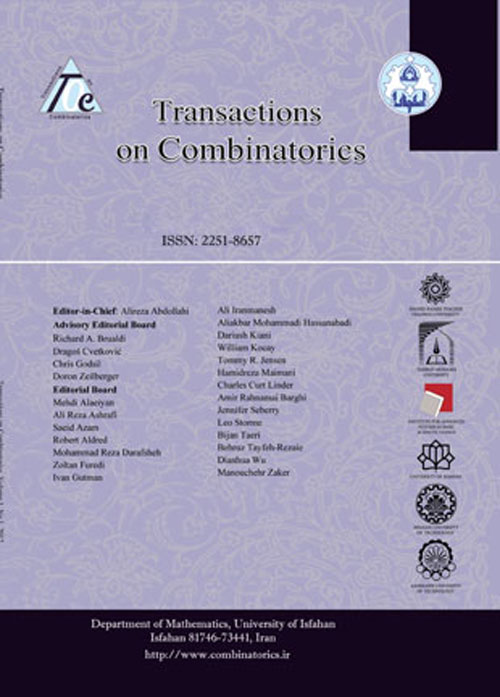فهرست مطالب

Transactions on Combinatorics
Volume:4 Issue: 3, Sep 2015
- تاریخ انتشار: 1394/05/25
- تعداد عناوین: 6
-
-
Pages 1-9Let G be a simple connected graph. The edge-Wiener index W e (G) is the sum of all distances between edges in G, whereas the hyper edge-Wiener index WW e (G) is defined as {\footnotesize WW e (G)=12 W e (G)+12 W 2 e (G)}, where {footnotesize W 2 e (G)=sumlimits leftf,grightsubseteqE(G) d 2 e (f,g)}. In this paper, we present explicit formula for the hyper edge-Wiener index of corona product of two graphs. Also, we use it to determine the hyper edge-Wiener index of some chemical graphs.Keywords: Distance, Topological index, Hyper edge, Wiener index, Corona product
-
Pages 11-23In this paper, the degree distance and the Gutman index of the corona product of two graphs are determined. Using the results obtained, the exact degree distance and Gutman index of certain classes of graphs are computed.Keywords: Corona product, Degree distance, Gutman Index, Wiener index, Zagreb index
-
Pages 25-35For a simple connected graph G with n -vertices having Laplacian eigenvalues μ 1, μ 2, …, μ n−1, μ n =0, and signless Laplacian eigenvalues q 1, q 2, …, q n, the Laplacian-energy-like invariant(LEL) and the incidence energy (IE) of a graph G are respectively defined as LEL(G)=∑ n−1 i=1 μ i − − √ and IE(G)=∑ n i=1 q i √. In this paper, we obtain some sharp lower and upper bounds for the Laplacian-energy-like invariant and incidence energy of a graph.Keywords: Spectra of graph, energy of graph, Laplacian energy, incidence energy
-
Pages 37-42For given bipartite graphs G 1, G 2, …, G t, the bipartite Ramsey number bR(G 1, G 2, …, G t) is the smallest integer n such that if the edges of the complete bipartite graph K n,n are partitioned into t disjoint color classes giving t graphs H 1, H 2, …, H t, then at least one H i has a subgraph isomorphic to G i. In this paper, we study the multicolor bipartite Ramsey number bR(G 1, G 2, …, G t), in the case that G 1, G 2, …, G t being either stars and stripes or stars and a path.Keywords: Bipartite Ramsey Number, Path, Star, Stripe
-
Pages 43-52In this paper, we prove the nonexistence of two weighing matrices of weight 81, namely CW(88,81) and CW(99,81). We will apply two very different methods to do so; for the case of CW(88,81), we will use almost purely counting methods, while for CW(99,81), we will use algebraic methods.Keywords: weighing matrices, circulant, multipliers
-
Pages 53-61Let G be a connected graph of order 3 or more and c:E(G)→Zk (k≥2) a k-edge coloring of G where adjacent edges may be colored the same. The color sum s(v) of a vertex v of G is the sum in Zk of the colors of the edges incident with v. The k-edge coloring c is a modular k-edge coloring of G if s(u)≠s(v) in Zk for all pairs u, v of adjacent vertices of G. The modular chromatic index χ′m(G) of G is the minimum k for which G has a modular k-edge coloring. The Mycielskian of G=(V,E) is the graph M(G) with vertex set V∪V′∪{u}, where V′={v′:v∈V}, and edge set E∪{xy′:xy∈E}∪{v′u:v′∈V′}. It is shown that χ′m(M(G))=χ(M(G)) for some bipartite graphs, cycles and complete graphs.Keywords: modular edge coloring_modular chromatic index_Mycielskian of a graph

